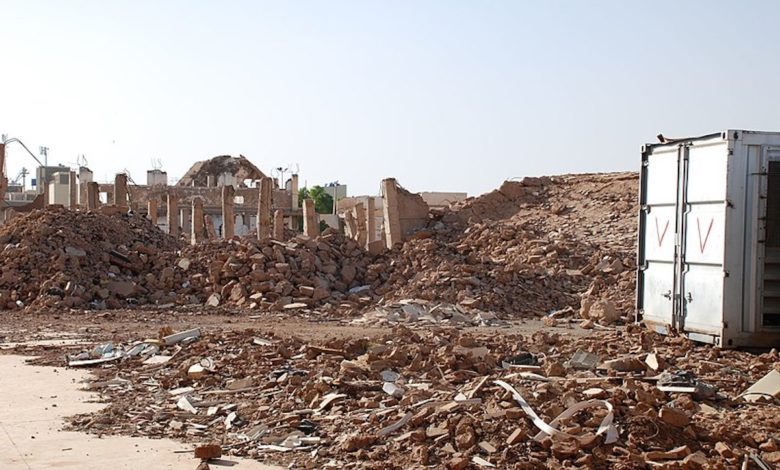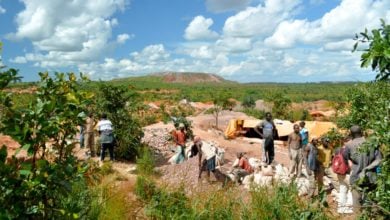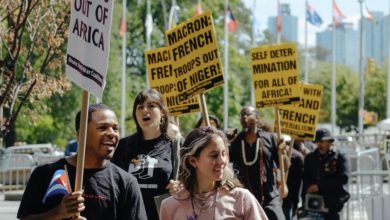
Twenty-five years ago, on Aug. 20, 1998, without warning, the United States bombed the largest pharmaceutical factory in Sudan. After destroying Sudan’s principal source of medicine, tens of thousands of people all over Africa likely died. This war crime has largely been scrubbed from living memory in the West.
The Clinton administration ordered the cruise missile attack on al-Shifa pharmaceutical factory — and a simultaneous attack on Afghanistan — two weeks after U.S. embassies in Tanzania and Kenya were bombed, acts attributed by the White House to its former ally, exiled-Saudi millionaire Osama bin Laden. The perpetrators of the Aug. 7 embassy bombings timed their attacks to take place eight years to the day after half a million U.S. soldiers were deployed to Saudi Arabia as part of the murderous 1991 Gulf War against Iraq, which left hundreds of thousands of Iraqis dead.
President Bill Clinton rationalized his retaliatory bombing of Sudan with unsubstantiated claims that al-Shifa was a secret chemical weapons factory connected to bin Laden. These were outright lies. As the New York Times later reported, “Indeed, officials later said that there was no proof that the plant had been manufacturing or storing nerve gas, as initially suspected by the Americans, or had been linked to Osama bin Laden, who was resident of Khartoum in the [1990s].”
The truth is that the embassy bombings gave the Clinton administration a pretext to do something they had increasingly fantasized about doing for years: direct military confrontation with Sudan’s government.
Searching for a path to regime change
Ever since Sudan opposed the 1991 U.S. war on Iraq, its policy toward Sudan had been destabilization. Washington viewed Sudan’s foreign policy moves and aspirations as a challenge to U.S. interests and those of its core Arab allies, namely Egypt’s military dictatorship and Saudi Arabia’s single-family monarchy.
That U.S. policy included sanctions, bans on loans and trade, backing for secessionist movements and bankrolling proxy wars. However, even though the U.S. was swimming in post-Cold War arrogance, when it came to “options that amounted to active U.S. intervention, policymakers backed off,” explained Donald Peterson, ambassador to Sudan between 1992-1995. “Ultimately it was not the [Clinton] administration but the U.S. public that narrowed the range of actions the United States might have taken against Sudan.” Following the 1993 defeat of U.S. forces by armed Somali citizens at the Battle of Mogadishu, U.S. officials calculated that the public might not be thrilled with another military intervention in Africa.
With the 1998 embassy bombings, however, the Clinton administration saw an opening and took it.
Though none of the perpetrators of the Aug. 7 embassy bombings were Sudanese and nothing connected the attacks to the country, the United States decided to hit Sudan. Their target: Sudan’s most prized, life-sustaining medicine factory.
Al-Shifa: ‘Pride of Africa‘
The al-Shifa Pharmaceutical Factory opened in 1997 to great fanfare in the presence of heads of state, foreign ministers and ambassadors. Its opening meant that Sudan’s self-sufficiency in medicine would rise from about three percent to over 50 percent.
It was partly financed by a nine-member association of Eastern and Southern African states that belonged to the Preferential Trade Area (PTA) treaty. Once online, the factory supplied most of Sudan’s pharmaceutical needs, as well as exporting products to other African and Middle Eastern countries.
Al-Shifa produced 90 percent of the drugs used to treat Sudan’s seven leading causes of death. Malaria and tuberculosis topped the list. It produced virtually all of the country’s veterinary medicine. Livestock, Sudan’s third largest export at the time, was vital to the economy and overall food supply.
Al-Shifa was the single most important facility in protecting the lives and health of Sudanese people. Few in Sudan could afford the high cost of foreign pharmaceutical products. Al-Shifa’s products averaged about 20 percent of the price on the international market. The government distributed 15 percent of the products free to low-income people.
Al-Shifa’s pharmaceutical production was known to the U.S. government. While strangling Iraq with genocidal sanctions, U.S. officials at the United Nations had approved the sale of medicines produced by al-Shifa for shipment to Iraq under the UN’s “Oil for Food” program.
When the plant was destroyed, so was half the medicine in a desperately poor country. Large-scale death ensued, mostly children, suddenly deprived of medicine needed to treat easily curable diseases.
“It is difficult to assess how many people in this poor African country died as a consequence of the destruction of this factory, but several tens of thousands seems to be a reasonable guess,” wrote Werner Daum, Germany’s ambassador to Sudan (1996 to 2000) three years later.
Clinton’s ‘weapons of mass destruction’ hoax
Only after destroying al-Shifa did the United States begin characterizing the plant as a highly secretive, tightly secured military site that made no commercial products.
Contrary to those claims, the plant was promoted by the Sudanese government as the “Pride of Africa.” It had a grand opening. Prominent international guests visited regularly. Large signs with directional arrows were displayed up and down roadways pointing cars toward al-Shifa’s main gate. Foreigners were allowed to enter the facility freely, it had no special security constraints, and all the country’s pharmacy students would visit as part of their training.
Nevertheless, Clinton charged that it was a secret “terrorist-related facility” involved in the production of chemical weapons for war. The engineers and managers that built and operated al-Shifa disagreed. Henry Jobe, the U.S. plant designer, said it was impossible. So did Tom Carnaffin, the British engineer who oversaw the plant’s construction. Carnaffin told the Chicago Tribune that “it just isn’t equipped to cope with the demands of chemical weapon manufacturing. You need things like airlocks but this factory just has doors leading out onto the street.”
The phony evidence
The White House publicly based its entire claim on a secret CIA soil sample, never shared with anyone, scooped up by an anonymous source somewhere outside the plant. It was said that the soil contained traces of EMPTA, one of four chemicals used to make nerve gas. EMPTA, however, also has civilian uses, which is why its production is allowed under the international Chemical Weapons Convention. One civilian use is pesticides and herbicides. Another is antibiotics, which al-Shifa produced.
The other part of Clinton’s phony rationale — that bin Laden had connections to the plant — also quickly fell apart. After the bombing, the Clinton administration listed the factory owner, one of Sudan’s richest businessmen, as a terrorist frontman for bin Laden and had his Bank of America assets frozen. Eight months later, shortly after a lawsuit was filed, the U.S. government quietly unfroze his accounts and pleaded sovereign immunity.
Osama bin Laden lived in Sudan from 1991 to 1996, on hiatus after helping the United States overthrow the progressive government in Afghanistan, which was trying to build socialism. War buddies turned into enemies, however, after the U.S. invaded Iraq in 1991 and Somalia in 1992. Two years before al-Shifa was flattened, Sudan expelled bin Laden at the request of the United States. He found refuge in Afghanistan where elements of the CIA-backed Mujahadeen had just seized power, fresh off drowning the socialist government there in blood.
Immediately after the al-Shifa bombing, Sudan’s government requested that the UN Security Council conduct an on-site investigation. Nearly every state in Africa and the Middle East supported the request. When a resolution was submitted calling on the UNSC to study “whether al-Shifa has been engaged in the production of chemical weapons ingredients” and “whether there exists any link … between al-Shifa and the Osama bin Laden terrorist network,” the United States vetoed it.
Why it happened
At first, the United States welcomed the Sudanese government, which came to power in 1989 through a military coup backed by Sudan’s regionally connected financial and business elites.
However, Sudan’s new elites began developing a foreign policy that upset U.S. regional control in both Africa and the Middle East. For instance, they opposed the 1991 U.S. war against Iraq and were a major supporter of the more militant Palestinian groups. The United States tried to isolate Sudan in international circles. Sudan responded by setting up the short-lived Popular Arab and Islamic Conference (PAIC) to rival the Organization of the Islamic Cooperation (OIC), an intergovernmental body that it viewed as manipulated by the West. Also, Sudan and Iran improved relations, generating western paranoia of a “Khartoum-Tehran axis,” stretching from the Middle East to Africa.
By 1996 and 1997, the Clinton team, which included imperialist regime-change fanatics like Madeline Albright and Susan Rice, had defeated those in favor of negotiations and “constructive engagement.” Overthrowing the Sudanese government through force of war became the preference. By 1997, Secretary of State Madeline Albright expressed her excitement for a “final onslaught.”
Frustratingly for Clinton though, Sudan’s government managed to survive, and by early 1998, U.S. regime change strategy was in a rut.
But then, two U.S. embassies in East Africa were bombed. The Clinton White House and CIA were intent on taking full advantage of the situation. And they did. They incinerated al-Shifa, the “Pride of Africa,” wiped out Sudan’s ability to indigenously manufacture medicine, and killed tens of thousands of innocent people all over Africa and the Middle East.




